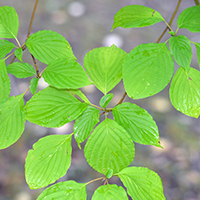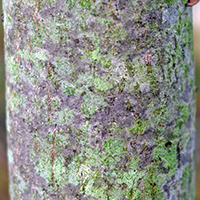What alternate-leaf dogwood looks like
Size and shape
- Slow growing shrub/small tree.
- Reaches 8 to 10 metres high.
Leaves
- Dark green on top and light green with fine hairs below (6 to 12 centimetres long).
- Half as wide with 5 to 6 deep, curved veins.
- Leaves are alternate and arranged in clusters at end of branches.
Bark
- Bright green with vertical white streaks.
- New growth/twigs are purple.
Flowers
- Creamy-white, occurring in clusters in May-June.
Fruit
- Berries are dark blue on red stalks.
- Grow in mid-summer.
Where alternate-leaf dogwood is found
Alternate-leaf dogwood is a common understory or forest-edge species throughout Southern Ontario and in parts of Central Ontario. Isolated populations occur near Thunder Bay and Lake of the Woods.
What to know to grow alternate-leaf dogwood
- Moisture: prefers evenly moist soils.
- Shade: prefers partial shade to full sun with plenty of moisture.
- Soil: prefers nutrient rich, acidic, well-drained deep soils.
- Planting tip: mulch well with 8 centimetres of bark mulch or plant near the sloped edge of a waterbody where roots can access water in summer.
Benefits and uses of alternate-leaf dogwood
Wildlife benefits
- Provides nesting habitat for birds.
- Twigs and leaves are browsed by rabbits, deer and beaver.
- Berries are eaten by birds, chipmunks and bears.
- The flower’s sweet smell attracts many types of insects for pollination, including butterflies, moths and other insects.
Commercial uses
Alternate-leaf dogwood is commonly grown as a landscape ornamental.
Fun facts about alternate-leaf dogwood
- Alternate-leaf dogwood is a host for larval spring azure butterflies. These showy butterflies are attracted to the flowers for their nectar.
Updated: November 22, 2023
Published: July 17, 2014




